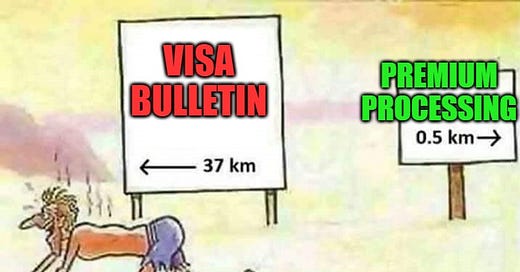Visa Bulletin Backlog versus USCIS Processing Time
This short post will clarify a sometimes confused point about how long people must wait for a U.S. immigration benefit.
This short post will attempt to explain something that is sometimes misunderstood about U.S. immigration processing.
When you want an immigration benefit - most commonly a green card - you have to consider both the USCIS, or US Department of Labor (DOL), or US Department of State (DOS) processing times, which are separate and distinct from any Visa Bulletin backlog.
The processing time is simply how long it takes a given agency to do its job. If you file a case with USCIS, if you file via premium processing, the case might be reviewed quickly in less than 3 weeks (for certain types of premium processing), or 45 days for EB-2 NIW I-140s or EB1(3) intracompany transferee manager I-140s.
If you file something via regular, non-premium processing, you are subject to potentially longer, undefined processing times by the relevant agency. But regardless of whether the filing is done via premium processing or regular processing, none of this relates to the Visa Bulletin which is totally independent to how long it may take to get the benefit you want.
A couple examples:
An I-130 petition for a sibling might take 2 years to be approved by USCIS. So the 2 years is the PROCESSING TIME. But totally separate from the 2 years at USCIS, there are Visa Bulletin cut-off dates that will implicate how long it will take for your sibling to get a green card.
In the EB (Employment-Based) context, an I-140 petition in the EB2 NIW category might take 6 months to be approved via regular, non-premium processing, and that is the USCIS PROCESSING TIME. But separate from the processing time, there is also the Visa Bulletin backlogs. Getting the I-140 approved does NOTHING to implicate the Visa Bulletin backlogs.
However, with that said, even if your priority date is not current per the Visa Bulletin, there may still be benefits to getting an I-140 approved quicker through premium processing.
If an I-140 is approved quicker, then if you are married and your spouse has H-4 visa status, your spouse can get an H-4 EAD work permit even if your priority date is not current. An H-4 EAD work permit is available for an H-4 spouse where the H-1B “principal” is the beneficiary of an approved I-140. Traditionally H-4 EADs were used almost exclusively by Indian-born H-4 spouses but with the Visa Bulletin cut-off dates now applying to all nationalities, there will be more nationalities considering the H-4 EAD.
If you are running out of H-1B time and you want clarity that you are eligible for H-1B time beyond 6 years, having an approved I-140 quicker will potentially help with that.
My point in this short post is not to say that premium processing is “worth it” or “not worth it.” I truly believe this calculation must be an individualized, case-specific consideration (although if your employer will pay - then yes, go for it!)
You have to consider a variety of factors including your own budget and the ‘value’ of getting things done quicker. I will say that everything seems to get slower and more frustrating so as a general rule I see the appeal in premium processing but given the relatively steep filing fee, it is worth assessing the cost versus benefit.
My point is that if you are waiting for an immigration benefit, you have to consider BOTH the agency processing time and separately any backlogs or waitlists that apply as a result of cut-off dates on the Visa Bulletin.




